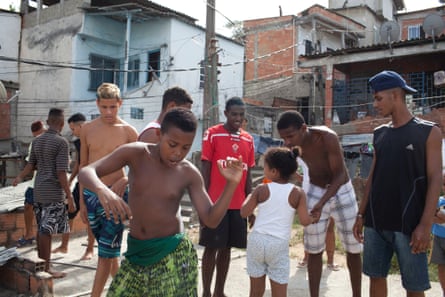H
Baile funk, a type of electronic music that originated 40 years ago in the favelas of Rio de Janeiro, Brazil, is characterized by explosive, thunderous kicks, unique and crisp cymbal sounds, and intense and at times, unintelligible vocals. It is best enjoyed through robust speakers and has become one of the most electrifying and unconventional genres to break into the mainstream culture.
The trend, which originated in Brazil but has now reached global popularity, has expanded beyond its borders and into various aspects of pop culture such as memes, fashion events, and music by artists like Cardi B and Travis Scott. One of the latest developments in this trend is bruxaria, a dark and rhythmic subgenre that emerged at parties known as fluxos in São Paulo’s favelas. This style of music, which features a four-on-the-floor beat, has also gained traction outside of Brazil and has given rise to a new genre called phonk. This internet-based music has taken elements from bruxaria and amplified them, resulting in a smoother sound that has exploded on platforms like TikTok and Spotify. In fact, Spotify’s main phonk playlist has nearly 7 million subscribers, making it one of the most popular in the world.
Priscila Cavalcante, also known as House of Pris, believes that baile funk has become an integral part of contemporary music, whether it is played in clubs or incorporated into other genres. She suggests that if music does not have the essence of funk, there may be something lacking in its composition.
The music genre known as baile funk greatly influenced Guilherme Galdino, a resident of São Paulo. Initially a fan, he later became DJ Arana and is now one of the leading figures in the bruxaria scene, along with fellow producers DJ Patrick R, DJ Blakes, and DJ K. Collaborating with popular MCs, DJ Arana creates tracks that have garnered over 210 million views on his YouTube channel. His sombre and eerie music, a departure from the typical tropical sounds associated with Brazil, has gained a monthly listenership of 7 million on Spotify. “My persona as a producer is like a character or game skin,” he explains. “I incorporate elements of horror into my music because it surprises people – I want to make music that invokes screams.”
The genre of Baile funk has sparked popular dance trends on the internet and is now making its way into clubs. Its fast-paced combination of elements has been mixed with various types of music, such as hard techno, reggaeton, and Afrobeats. DJ Arana’s music has gained popularity worldwide, from Japan to Switzerland.

In the early 2000s, Cavalcante’s experience was completely different as a person in her twenties. She left Brazil and moved to Europe to pursue a career in music. She settled in Amsterdam and began DJing 90s baile funk. However, she found that people in Europe did not seem to enjoy it and only a few people would dance to these songs at clubs. Cavalcante had initially fallen in love with baile funk at lively parties in her hometown of Fortaleza, located in the northeastern state of Ceará in Brazil. She recalls crying the first time she heard “It’s Automatic” by the American group Freestyle, which was a popular hit in Rio de Janeiro’s suburbs and frequently played on the radio and by top DJs.
The song was a popular choice on a compilation album released by Furacão 2000, a prominent baile funk group in 1988. These groups became popular in the 1970s, hosting parties in Black communities and favelas with funk music inspired by artists like James Brown and Tim Maia from Brazil. Over time, the music evolved with influences from Miami bass, New York freestyle, and Los Angeles electro, but the genre was still known by similar names such as funk carioca and favela funk.
During the 1990s, the trend of baile funk continued to develop and gained widespread attention in Rio, leading to increased scrutiny. The media and political figures often associated the scene with violence and drug trade. However, despite this negative attention, the catchy tamborzão rhythm, which is unique to baile funk, spread to other cities in Brazil such as Fortaleza, Recife, Belo Horizonte, São Paulo, and even internationally.
According to Cavalcante, there was a resurgence of baile funk in the mid-2000s, with MCs becoming the main focus instead of DJs. The 2004 compilation Rio Baile Funk: Favela Booty Beats, curated by German DJ Daniel Haaksman, helped introduce the sound to a wider international audience. American DJ Diplo also became a notable advocate for the genre, incorporating it into his productions with Brazilian musician Deize Tigrona, British rapper MIA, and Jamaican-American dance music trio Major Lazer. Their 2009 song “Pon De Floor,” which was influenced by baile funk, served as the foundation for Beyoncé’s 2011 hit “Run the World (Girls).”

Cavalcante has amassed a collection of almost a thousand baile funk vinyl records, and is now based in Miami, one of the main hubs for sounds that made up baile funk in the 80s. She has made a name for herself spinning early funk tracks that meld together Brazilian Portuguese vocals and Miami bass beats. “The first party we had here was crowded,” she says. “And we didn’t have an Instagram account whatsoever.”
The American pop charts appear to be the new territory to conquer: Cardi B and Megan Thee Stallion’s “Bongos” or Travis Scott’s “K-pop” may not impress experts, but both songs are influenced by recent versions of baile funk. Additionally, there’s Anitta, a groundbreaking Brazilian pop artist who started out as a baile MC before achieving global fame.

Taisa Machado is a performer, scholar, and one of the organizers of the first major exhibition dedicated to baile funk in Rio, held at the Museum of Art of Rio. She wonders, “Are people abroad actually listening to Anitta? What type of funk are these international DJs playing? It’s all a bit unclear now.” She reflects on the genre’s rise to global success, saying, “It’s like a ‘I told you so’ moment, but there’s also a sense of panic. There’s a concern that non-Brazilian artists will start producing baile funk without collaborating with Brazilian artists. I worry that mainstream artists only scratch the surface of the genre, while underground artists don’t receive the recognition they deserve.”
Rennan da Penha, a prominent DJ in Rio known for his baile funk music, has 1 million followers on Instagram. He is currently leading a campaign against what he refers to as “TikTok baile funk.” These tracks, which are widely shared on the platform and have spawned viral dance moves, are not welcome at his crowded parties. According to Machado, the rise of TikTok dance trends has caused many baile funk dancers, known as passinho dancers, to lose their influence to TikTok influencers. There is also a perception that baile funk, much like in the 90s and 00s, is looked down upon by high society. As evidence of this, there are no funk artists nominated in the new category for best Portuguese-language urban performance at this month’s Latin Grammys.
Even as baile funk gains popularity worldwide, Cavalcante hopes that producers continue to mix it with other genres such as reggaeton and hip-hop. She believes that this blend adds energy to the genre and helps it become more global. Machado also recognizes the importance of blending cultures, noting that Brazilian DJs and producers are incorporating elements of house, Afrobeats, and amapiano (a South African dance music) into baile funk. They are paying attention to the international music scene and incorporating new sounds into their work.
Machado believes that Brazilian baile funk artists have an advantage due to their access to baile funk street parties in the favelas where the genre originated. These parties played a crucial role in introducing Cavalcante and Arana to the distinctive beats and vocals that continue to shape their music today. According to Machado, the bailes are the breeding ground for new trends in baile funk and one’s personal experiences in the favela are essential for creating authentic funk music. In essence, funk is synonymous with favela life.
Source: theguardian.com



















